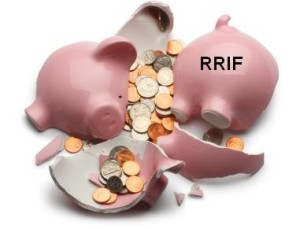 My latest MoneySense Retired Money column has just been published and covers something that was a new experience for me: starting and managing a RRIF or Registered Retirement Income Fund.
My latest MoneySense Retired Money column has just been published and covers something that was a new experience for me: starting and managing a RRIF or Registered Retirement Income Fund.
You can find the full column by clicking on the highlighted headline: How to make sure you have enough money to fund your RRIF withdrawals.
At the end of the year you turn 71, those with RRSPs are required either to cash them out (not recommended from the standpoint of taxes), to to annuitize orto convert it into a RRIF, or Registered Retirement Income Fund. The latter is the most popular action and recommended by experts like The Successful Investor’s Patrick McKeough.
However, as I’ve discovered since my own RRIF started up this past January, the sweetness of the RRSP tax deduction over the decades is offset by the sourness of having to pay taxable withdrawals on your new RRIF.
In my case, I am a DIY investor who uses one of the big-bank discount brokers to self-manage the taxable distributions and to manage the remaining investments, most of them carryovers from the RRSP. While accumulating funds in an RRSP is a matter of making annual contributions and reinvesting dividends and interest, a RRIF represents a departure from the psychology needed to build an RRSP for the future. Suddenly, regular selling is necessary. The RRIF rules mean that in the first year you’ll have to withdraw something like 5.28% of what your balance was at the start of the year (rising to 5.4% at age 72 and every upwards each passing year).
Payments can quarterly, monthly or any frequency you choose
If you choose monthly payments, as I did, that means every month you have to have 1/12th of the required annual distribution in the form of ready cash to be whooshed out monthly on whatever date you specify. As most retirees will be getting other pensions near the end of the month, I chose mid-month for the RRIF distribution. You also need to choose the percentage of tax you wish to pay to Canada Revenue Agency: I picked 30%, which automatically leaves your account each month. The remaining 70% transfers out into your main chequing account, ideally at the same financial institution where the RRIF is held: It’s easier that way.
Setting regular tax payments
You also need to choose the percentage of tax you wish to pay to Canada Revenue Agency: I picked 30%, which automatically leaves your account each month. The remaining 70% transfers out into your main chequing account, ideally at the same financial institution where the RRIF is held: It’s easier that way. Sure, you could set the tax at 10% or 20% but if you have other sources of taxable income, like taxable dividends and other pensions, I’d rather not have the unpleasant surprise of a larger-than-expected tax bill a year from April. Once you have a year of RRIFing under your belt, you may see fit to adjust the 30% upwards or downwards.
So in the example in the MoneySense column, if you have to take out $1,000 a month, $300 goes to the CRA and $700 goes to your bank account automatically. The moment that happens, it’s up to you to make sure you’ll have another liquid $1,000 ready for the following month. This will often mean you have to sell something to raise the cash. Even if you have laddered GICs, I doubt most retirees will have the necessary amounts coming due every month from locked-in GICs. More likely, you’ll have to sell some bond ETFs or units in those much-beloved asset allocation ETFs, or individual stocks or bonds.
Keep Asset Allocation in mind when choosing which securities to sell
The column consults several well-known financial experts on the topic of what securities to sell from your RRIF in order to come up with the distributions. It’s generally advisable to try and keep your Asset Allocation to its pre-determined target, so if you’re at 50% stocks to 50% bonds, ideally you’d be selling both stocks and fixed-income in equal proportions. But keep in mind that once you’re at the mandatory RRIF age of 71, your time horizon has begun to shrunk, and it’s normal at this age to start raising Fixed-Income exposure at the expense of stock exposure. Given how volatile markets have been lately under Trump 2.0 and his crazy Tariff scheme, you may want to sell more stocks when markets are rallying, saving some cash for the inevitable downdraft that may follow. See for example this recent blog by John De Goey, one of the experts cited in the full column.


Jon, I don’t understand the rationale for monthly withdrawals – aren’t you just giving the taxman a free loan until the tax reconciliation? Personally I accumulate the required withdrawal amount inside the RRIF in a money market account (meagre amount I know but not zero) until December and then make the withdrawal with the 30% withholding rate.
For me, it’s simply a Cash Flow consideration. Lots of monthly expenses can be handled by extra monthly income. Before the RRIF, I would “liberate” one big RRSP lump sum per year as you do.